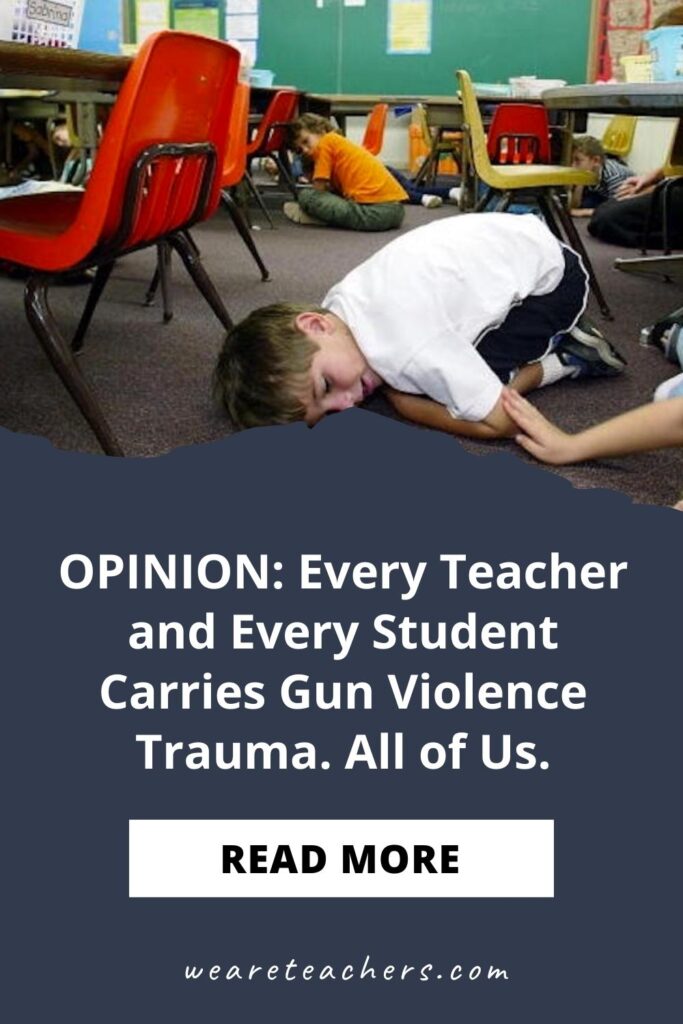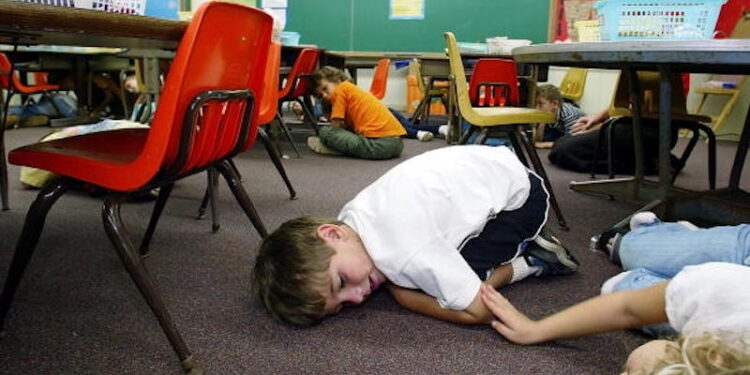News continues to trickle out about the Uvalde school shooting, but in many ways, it already feels like it’s fading out of public consciousness. Summer is here. Kids are out of school, and with the threat of school gun violence feeling less possible because schools are empty, people are allowing themselves to forget. Like always.
But for the teachers and students who spend 180 days a year (or more) in school, gun violence trauma doesn’t fade away with the next news cycle. We carry it with us every day. And more and more, it’s starting to feel like one more weight slowly crushing the mental health of everyone involved.
Conversations I could never have imagined before are now commonplace.
We just wrapped up our first active shooter drill of the year. Just like in previous years, the students want to talk about what we would do. What will we do when it actually happens? I say what I’ve said every year since I experienced my first active shooter drill. We will lock our door and stay out of sight. We will listen carefully to see if there is a “safe” moment when we can make a run for it. And if the unthinkable happens and someone with a gun enters this classroom, I will attack them. And while I’m pulling their hair, scratching their eyes out, and biting them with all my strength … I expect my students to run. Run out of the building to safety.
Our children are making decisions even adults shouldn’t be asked to make.
Truthfully, that last part usually gets some laughs. At five feet tall, the thought of their cardigan-and-maxi-skirt-clad English teacher going all honey badger on a school shooter is quite an image. And I’m happy they can still laugh about this. But I assure them I’m serious. “That’s my job,” I tell them. “I volunteered to protect you all, with my life if necessary … although I really hope it never comes to that.” We talk about fighting back. About throwing desks and chairs at the intruder. Often, a few of the young men in class object to my plan. “I’m not OK with letting you take a bullet for me, Mrs. Mathis. No offense, but I’m a guy. It’s supposed to be my job to protect you.”
Children are now used to contemplating their own deaths at the hands of school shooters.
Just stop and think about that. A 14-year-old boy has processed and accepted that in his worldview, part of being a man means he might have to jump in front of a person with a gun to protect his teacher from getting shot. Even as I type it my brain struggles to accept that this is reality. I tell them the truth. That I am deeply touched by their chivalry and honor, but no one will be in front of me if we charge the attacker. They can fight alongside me. But I will be the main target. I am the adult. Their teacher. And I expect them to run to safety as soon as they can. Several of them grumble. But we all accept this reality and get back to our lesson.
Every time I have this conversation I marvel at my students’ desire to protect one another (and me). And every time, I wonder what long-term effects this sort of reality will have on them as they grow.
Managing threat levels is now just part of the “new normal.”
Another school year. Our vice principal comes over the PA system. “Secure in place. Secure in place. Secure in place.” I’m not overly concerned. This isn’t the language for an active shooter situation. We are all to remain in our classrooms until further instructions are given. No students can leave to use the restroom or water fountains. If the bell rings, we don’t move to the next class period. This is usually because there’s something going on in the hall (drug-sniffing dogs, a student having an outburst, etc.) and they want it to remain clear of students. I continue the lesson.
Teachers are learning how to hide our own fears for the sake of our students.
Suddenly, the PA system crackles to life again. Our vice principal’s voice sounds different this time. Serious. Concerned. “We’re going to move immediately to a lockdown procedure. Lock down. Lock down. Lock down.” This is the active shooter announcement. And it’s not a drill. I quickly walk to the back of my classroom, conscious of maintaining a calm, in-control appearance. I remove the magnet from my door, make sure it’s locked. Quickly, I check the hall for any students who I may need to pull into my room and, I realize with a cold shock, for the shooter. I shut the door, turn off the lights, and instruct the students to move out of the line of sight from the door. Several students express concern. A few are immediately terrified. “It’s nothing, guys. Relax,” I say, squeezing a few shoulders reassuringly as I listen for gunshots.
I don’t want to die today. I did not sign up for this.
As I smile and tell the students that they can use their phones as long as they’re on silent (after all, maybe one of their friends in another part of the building will hear the shots and then we’ll know where the shooter is), I realize I may have to keep my promise to my students today. I may have to sacrifice myself to save them. I may die today. So might my students. And as sure as I am that I would die for any one of them, another thought is also running through my head. I don’t want to die today. I did not sign up for this.
From thinking we might die to getting ready for tomorrow’s vocabulary quiz …
Twenty minutes later the vice principal’s voice calls out again. False alarm. Everything’s fine. Students can proceed to their next class. A bit shell-shocked, I hug a few students who are still upset. I tell them to breathe. That they’re OK. I write a pass for a girl in tears to go to guidance. I get ready to teach my next class.
Later in the day, an email arrives letting us know that there were reports of a suspicious person walking around the elementary school next door. Someone reported that it looked like they may have had a gun, but they were wrong. There was no danger. No danger. Other than the trauma of an entire school full of children and their teachers wondering if today was the day we were going to die.
We can’t go on like this.
Like many teachers and students in this country, I never experienced actual gun violence during my 18 years as a classroom teacher. I was lucky. But that doesn’t mean that I’ve been unaffected by each incident of gun violence that has taken place at schools around the country. We are all affected. Each drill, each news story, and each new, tragic shooting adds another layer to the trauma our nation has seemingly accepted as normal.
For teachers, this may be manifesting in the increased feelings of burnout and secondary traumatic stress. Or in the record number of teachers who are considering walking away from the profession they never thought they’d leave. It’s also visible in the number of educators who are loudly demanding change from our government. Discussions of walk-outs, electing leaders who are serious about gun control, and fully funding mental health services are all being discussed more fervently than ever before.
For now, our students have accepted that they are not safe at school. They plan for how they will survive or, in far too many cases, how they will sacrifice themselves for their friends or teachers if necessary. What will the long-lasting effects of gun violence trauma will be? And what does the future hold for the young people who will bring this sustained trauma with them into adulthood?
How are you coping with gun violence trauma? Come join the conversation in our Facebook WeAreTeachers Helpline group.





















